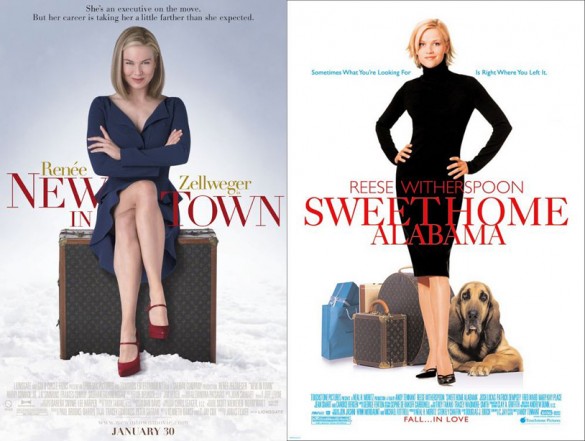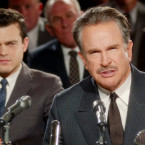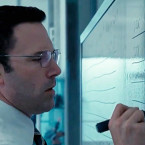News & Notes Inside the Week in Film
I’m Calling Bullshit
Studio executives and theater chain CEOs alike agree that long running times cut into a film’s profits. There’s only one problem with this: it’s completely false.
by Chris Neumer
For a number of years now, Hollywood studios and theater companies have been trotting out the line that movies with long running times are a financial burden. I first remember seeing this statement employed by Warner Brothers head of distribution, Dan Fellman, after Watchmen opened to less than predicted numbers. Fellman told the AP, “[Watchmen] is a movie that runs two hours and 45 minutes. That really only leaves the exhibitor with one showing a night. If you have an 8 o’clock show, the next show is at midnight. So with essentially one show a night, I think [this box office take] is outstanding.” When I first read that, my immediate reaction was to question, “Then why didn’t you just make the movie shorter?” If long running times clog the theaters, why not cut the running times of the movies to make more money? (SEE THE ORIGINAL STORY BELOW).
This focus on the number of show times per day popped up sporadically throughout the next few years—interestingly, never when talking about long movies that made lots of money—and hit a near fever pitch during this current Oscar season. Everywhere I look, a theater owner or studio executive is lamenting the long running times that the Oscar nominees have had on their bottom lines. Entertainment writers are jumping on this bandwagon and writing stories that could actually qualify as news stories about the ever increasing length of movies and how this could impact audiences in the future as the box office results shrink thanks to a lack of show times.
The CEO of Landmark Theaters, Ted Mundorff, was quoted in The LA Times as saying that each movie playing at his theater chain with a running time of more than two hours cost his company more than $25,000 a week.
The math is not pretty. Landmark has 51 different theaters. Assuming that two screens at each theater are playing a movie with a longer than two hour running time (a distinction that includes Life of Pi, Zero Dark Thirty, Lincoln, Django Unchained, Argo and Silver Linings Playbook), the company is losing almost $2.6 million in revenue a week thanks to these filmmakers incessant need to go on at length. That’s more than $10 million in the month of January! Landmark is taking a bath this Oscar season!
Or…
The whole thing is complete and total bullshit.
There are many things wrong with the above scenario—namely that money is being lost by the long running times of films—it’s hard to know where to begin. Single out any one part of it and the logic therein quickly falls apart. Let’s investigate:
• Long Movies Are At A Financial Disadvantage to Shorter Movies
Do you know how many of the top ten box office hits of all time have a running time of less than two hours? One. Shrek 2.
Of the top twenty live-action box office hits of all time, do you know how many have a running time of less than two hours? Zero.
Of the top forty live-action box office hits of all time, do you know how many have a running time of less than two hours? One. Alice in Wonderland. (And as an aside, I remember that movie feeling like it was at least 150 minutes long).
It is truly an amazing statistic: of the top 50 biggest hits of all time, only six (five animated films and Alice in Wonderland) have a running time of under two hours.
The average length of the five biggest hits of all time is a whopping two hours and thirty seven minutes (157 minutes). That’s how long Zero Dark Thirty is and five minutes shorter than Watchmen is. If you want me to buy into the concept that long running times mean less money, you probably shouldn’t attempt to convince me using anything remotely resembling a statistic. Not only does it not seem like a film’s running time is a stumbling block to financial success, it could actually be argued that longer running films do better at the box office than their shorter compatriots.
• The Theaters Are Losing a Showing a Day with Longer Movies
There’s a ‘yes’ and a ‘no’ to this. The whole thing brings to mind that classic Simpsons scene when an attorney tells the Simpsons that they shouldn’t be confused; he occasionally keeps talking after people leave the room. Yes, sometimes theaters are down a showing a day, but sometimes theaters aren’t: it turns out that when Hollywood types say that they’re down a showing a day, they specifically mean that they’re down a showing between 7:00-9:30PM. Instead of two showings during that time period, they’re down to one. Since that is the main time that people go to see movies—one article estimated that 80% of a theater’s revenue comes between 7:00-9:30PM—that really hurts. Except for the part where theaters can have one showing at 6:45PM and another at 9:45PM and it isn’t that big of a deal.
• This Lost Showing Costs the Theaters Significant Amounts of Money
Let’s say that 500 people want to see the movie Lincoln and there are five showings. That averages out to 100 people per showing. If you remove one of those showings, which one of the following happens to the 100 people who would have otherwise gone to that now lost showing?
- Do they now stay home? Or,
- Do they simply go to one of the other showings?
According to Landmark and Hollywood, the answer is A. (This is the logic at the core of their argument that they are hemorrhaging money with four showings a day instead of five). And this is, of course, patently ridiculous. If 500 people want to see Lincoln, they will all figure out when they can see it and go.
The theaters’ logic on this is really quite flawed. Think about it this way: if the number of performances of something actually dictated financial success, baseball would be ten times more profitable than football because they play ten times as many games (162 to 16). The actual numbers suggest a different story with the MLB pulling in $7.5 billion and the NFL $9.5 billion.
It’s really sad when statistics, numbers and facts get in the way of a good story.
Next week I’m going to get into the other aspect of this story that is patently false: that the movies of today are getting longer.
Flashback to 2009: Managing Expectations: The Watchmen Edition
Warner Brothers’ new film, Watchmen, opened to less than stellar results this last weekend. The explanation for its stumbles is certainly unique.
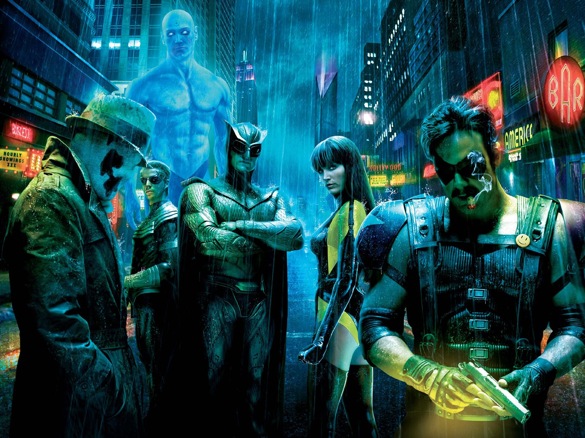 by Chris Neumer
by Chris Neumer
Before Watchmen was released to theaters, box office analysts were debating about whether the film would be able to pull in $75 million during its opening weekend. The film was compared often to 2007’s 300. Both films were directed by Zack Snyder, aimed at teen boys and were released by Warner Brothers in the month of March. 300 opened with almost $71 million. It wasn’t a stretch to suggest that Watchmen might be able to top that figure.
Except it didn’t. Watchmen pulled in a little more than $55 million during it’s opening weekend.
Attempting to spin the multi-million dollar discrepancy between expectations and results, Warner Brothers unleashed Dan Fellman, its head of distribution. Fellman stated that it was unfair to compare Watchmen with 300* and went on to explain that Watchmen and 300 are two unique entities. “They’re two different movies,” Fellman stated. “[Watchmen] is a movie that runs two hours and 45 minutes. That really only leaves the exhibitor with one showing a night. If you have an 8 o’clock show, the next show is at midnight. So with essentially one show a night, I think this is outstanding.”
*Just ignore the fact that Fellman himself compared Watchmen and 300 in the Hollywood Reporter less than a week before he stated it was unfair to compare the two. On March 3, The Hollywood Reporter quoted Fellman as saying, “After the success of 300, there wasn’t an exhibitor in the country who didn’t want to play Zack Snyder’s next movie.”
You’ll have to forgive Fellman’s math. Theaters really don’t need 75 minutes between the end of one showing and the beginning of the next. More importantly, theaters themselves seem to understand this. Hollywood’s ArcLight had Watchmen showing in one theater and managed to find a way to have two showings an evening; one at 7:05 and one at 10:40.
So the choice is ours. Do we take this to mean that the head of Warner Brothers distribution has no idea how the theaters work and how much time they need between showings? Do we take this to mean that Watchmen could have made significantly more money if it was shorter? The latter, of course, begging the question: then why didn’t Warner Brothers cut its 165 minute running time down? Or do we take this to mean that Warner Brothers is trying to put a positive spin on some otherwise ugly looking numbers?
Whichever is true, this could go a long way to explaining why Warner Brothers is not doing as well financially as it had hoped.
The Photo of the Week
New in Town and Sweet Home Alabama Posters
Imitation is the most sincere form of flattery. I’m just surprised that single women on the go only have one brand of luggage to choose from. C’est la vie.
The 5 Things I Learned This Week
Fascinatingly true things to broaden your mind
1) Exceptional drought, extreme drought, severe drought and moderate drought all mean different things according to the government agency that monitors such things..
2) In the press kit for Transformers, there were five photos of director Michael Bay and seven photos of the film’s star, Shia LaBeouf.
3) Actor Kevin James was born Kevin Knipfing.
4) Saturday Night Live’s producer, Lorne Michaels, once approached Albert Brooks about being the shows permanent host.
5) Sharon Stone majored in creative writing while in college.
This Week’s Stories
- Never Let Facts Stand in the Way of a Good Story
- Flashback to 2009: Watchmen’s Opening Weekend is Not Good
- The Photo of the Week
- Trivial Fascinations: The Five Things I Learned This Week
- The New Releases
New Releases
Bully
 THE PLAYERS: Starring Alex, Ja’Maya, and Kelby; written by Lee Hirsch and Cynthia Lowen; directed by Lee Hirsch; Released by The Weinstein Company. Rated PG-13.
THE PLAYERS: Starring Alex, Ja’Maya, and Kelby; written by Lee Hirsch and Cynthia Lowen; directed by Lee Hirsch; Released by The Weinstein Company. Rated PG-13.
THE PLOT: A documentary examining bullying in the American school system.
THE SKINNY:
+/- Not the film by Larry Clark.
– There were times during this movie where I found myself wondering two different questions: 1) Why were the little assholes picking on their classmates in front of the cameras? And, 2) Couldn’t the cameramen have done something? Yelled, “Hey, stop it!” or something?
– I feel about Bully much the same way as I felt about An Inconvenient Truth: after about 15 seconds of the movie, I was convinced the topic at hand was an issue; the question then became, what can I do about this? And after perusing the film’s website and reading a number of articles about it, I still don’t know.
The problem, of course, is that the film was not made for people who accept that bullying is an issue for some kids. It was made to convince skeptics that bulling is, indeed, an issue for some kids. But my point remains salient: what can I do about this? I’d like to know. Maybe there needs to be a Dexter like bully for the bullies. He only bullies the bullies. This might be thinking a little too far out of the box.
+ Bully is a well-made film, even if it doesn’t explain what I can do to help reduce incidences of bullying.
– I’m not 100% sold that Lee Hirsch quite understands how kids and teens work. At times, this film feels like a movie made about bullying by someone who had never gone to school of any sort.
+ This is neither here nor there, but I have a foolproof solution on how to stop bullying almost immediately. While this may sound slightly flippant, I mean it in all seriousness. Go directly to the ten hottest, most popular girls in the school and tell them that they will get great letters of recommendation for college if they take a stand against bullying. Assign them each a geek to mentor (think of a big brother program, except for nerds) and, within a week, all bullying will have ended. No one will want to endure the wrath of the popular crowd. Will no one ever put the hot girls’ power to good use?
YES, IT’S TRUE: This film was originally rated “R” for language, but the language was cut out so that the movie could be shown to teens.
CrocZilla
 THE PLAYERS: Starring Tao Guo, Barbie Hsu and Suet Lam; written and directed by Li Shen Lin. This film is unrated.
THE PLAYERS: Starring Tao Guo, Barbie Hsu and Suet Lam; written and directed by Li Shen Lin. This film is unrated.
THE PLOT: A huge crocodile terrorizes people after escaping being eaten by a Chinese gangster.
THE SKINNY:
– While this movie does feature a very large crocodile—a 36 footer, which is so far beyond the realm of possibility it would be the equivalent of an 11-foot tall human—it isn’t a mega croc or a dino croc and isn’t quite able to take a bite out of the corner of a tall building and have it then fall down. Sigh. A man can dream…
+ That said, the croc in question does have no problem going through the walls of houses with apparent glee.
– You definitely will not glean that the aforementioned crocodile cannot eat a building from the movie’s box art (and new title and tagline). Featuring some of the worst photoshopping outside of a junior high computer lab, Croczilla (nee: Million Dollar Crocodile) has a new poster featuring the titular croc apparently eating a 14-story building. It also mentions that Japan was just the start, but since the entire movie takes place in China, I have no idea what this has to do with anything. I can’t believe I’m going to actually write this, but people renting/buying this movie expecting a cheesy SyFy animal movie are going to be sorely disappointed.
+ If you squint, the plot of this movie could be construed as Die Hard, where the croc is John McClane and people deciding to try and eat him is Hans Gruber storming Nakatomi Plaza. Here’s just a regular guy, enjoying his peaceful life, trying to spend time with friends and all of a sudden, thanks to an asshole with a gun who has big criminal plans, the regular guy is forced to go on the attack. Then shit gets real. Of course, to make this metaphor truly work correctly, John McClane would have had to have eaten a bag containing a million dollars, but I digress.
YES, IT’S TRUE: Crocodiles first appeared about 55 million years ago.
The Sessions
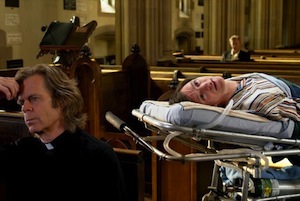 THE PLAYERS: Starring John Hawkes, Helen Hunt, and William H. Macy; written and directed by Ben Lewin. Released by Fox Searchlight. Rated R.
THE PLAYERS: Starring John Hawkes, Helen Hunt, and William H. Macy; written and directed by Ben Lewin. Released by Fox Searchlight. Rated R.
THE PLOT: A man struck with polio hires a sex surrogate to take his virginity.
THE SKINNY:
– You’re not going to see this movie. It’s too depressing or too indie or too triumphs-in-the-face-of-adversity or too stupid or too focused on sex or too inspirational or too something. This is a movie that is made for about seven people and those people saw it in the theaters.
Something else that needs to be mentioned is that it is next to impossible to categorize an audience’s expectations for The Sessions correctly. It is not the best movie ever made, nor does it feature the best acting performances in history. It is a good movie that will not generate a lot of passion in a lot of people. Those people who are inspired by it will be really inspired by it though, which will of course further skew future audience expectations.
– John Hawkes plays a man, Mark O’Brien, who, thanks to polio, is paralyzed below the neck. This movie is about O’Brien’s attempts to lose his virginity… and in spite of this extremely worthy Oscarbait, Hawkes wasn’t even nominated for a Best Actor statue. Just something to think about when you realize that Bradley Cooper was nominated for simply playing a bipolar guy trying to get his life back on the right path.
+ The converse of the above statement is that Hawkes does a fantastic job in his role, as does Helen Hunt in hers. Hunt was nominated for her performance here.
+ The movie is very warm and sweet.
YES, IT’S TRUE: Alan Alda and Mia Farrow are among the many survivors of polio.
Skyfall
 THE PLAYERS: Starring Daniel Craig, Javier Bardem, and Naomie Harris; written by Neal Purvis, Robert Wade, and John Logan; directed by Sam Mendes. Released by Sony Pictures. Rated PG-13.
THE PLAYERS: Starring Daniel Craig, Javier Bardem, and Naomie Harris; written by Neal Purvis, Robert Wade, and John Logan; directed by Sam Mendes. Released by Sony Pictures. Rated PG-13.
THE PLOT: James Bond (Daniel Craig) takes on a former MI6 agent (Javier Bardem) bent on destroying the organization.
THE SKINNY:
– Because of the financial success of what Chris Nolan did with Batman—he took a ridiculously cartoonish character and situation and dealt with them hyper realistically—we are now seeing this being done across the board with the biggest name franchises. The James Bond series is no different. Ever since Daniel Craig replaced Pierce Brosnan as the titular character, Bond is now experiencing things like pain, remorse, loss and has feelings that are directed towards women other than hornyness. It’s all very disconcerting. The one constant throughout the Bond series, the one element that separates Bond from the grand majority of other action heroes, is that he is cocksure at all times regardless of whether he’s facing imminent danger or not. He has irrational confidence at all times. The new Bond does not. It’s just strange to me that the filmmakers have taken all the things that made James Bond the man (and series) what they were… and the box office results have been stunning. Who knows, maybe the problem with the earlier Bond films was that they featured James Bond.
+ Adele’s song “Skyfall” is fantastic and phenomenal all at the same time.
– The villain in Skyfall is just a dude. Actually a dude who has less skill, moxie, money and talent than Bond himself. Raoul Silva is a former employee of MI6 who was fired and decides to take out his anger on his former boss. Yes, that’s the plot. Like a souped up version of a postal worker returning to his office with a gun.
– The last twenty minutes of Skyfall are, no kidding, like a grown up Home Alone.
YES, IT’S TRUE: In over 50 years of Bond film, Skyfall is only the second where Bond suffers a gunshot wound. The first takes place in Thunderball.
The New Releases were written by Chris Neumer and Kevin Withers
Columns |
Columns |
Columns |
Columns |
Columns |
Columns |
Columns |
Columns |
Columns |
Columns |
Columns |
Columns |

